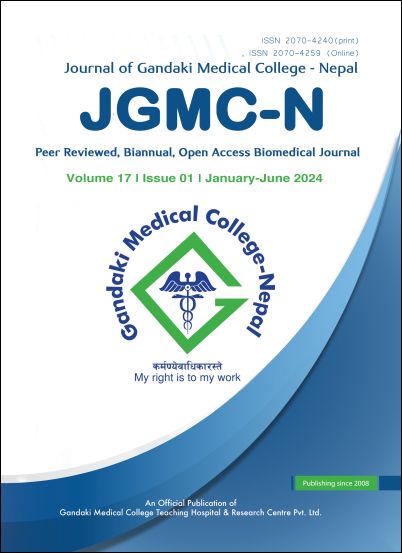Comparative study on the efficacy of perineural vs intravenous dexamethasone as an adjunct to bupivacaine to prolong analgesia after axillary brachial plexus block in a tertiary care center, Pokhara
DOI:
https://doi.org/10.3126/jgmcn.v17i1.61120Keywords:
Axillary brachial plexus block, bupivacaine, dexamethasone, perineuralAbstract
Introduction: In resource-limited settings, adjuvant drugs offer an alternative to extend peripheral nerve block analgesia. This study compared perineural and intravenous dexamethasone for post-operative analgesia in upper limb surgery patients under axillary brachial plexus block.
Methods: An experimental study was done on 60 patients undergoing unilateral upper limb surgery under axillary brachial plexus block, randomized into two groups. Group A received bupivacaine 0.25% 30ml with perineural dexamethasone 8mg, and Group B received the same bupivacaine dose with intravenous dexamethasone 8mg. The duration of analgesia, reported as the time of breakthrough pain at the operative site, was considered the primary outcome. The duration of sensory blockade, VAS scores, and postoperative rescue analgesic consumption were noted. Student’s t-test applied to compare difference in mean between two groups.
Results: In 60 patients (30 per group), group A showed a statistically significant longer duration of analgesia (9.67±0.92 hours) than group B (8.89±0.93 hours) (p=0.002, 95% CI 0.31–1.27). VAS scores at 4 and 8 hours postoperatively were significantly lower in group A (1.20±0.85 and 1.97±0.67) than in group B (1.80±0.85 and 2.60±0.72). Group A also had significantly lower rescue analgesic consumption (4.17±9.48 mg) than group B (12.50±17.06 mg) (p=0.023).
Conclusions: Perineural dexamethasone significantly prolonged analgesia compared to intravenous dexamethasone in patients undergoing upper limb surgery under ultrasonography-guided axillary brachial plexus block.
Downloads
Downloads
Published
How to Cite
Issue
Section
License
Copyright (c) 2024 The Author(s)

This work is licensed under a Creative Commons Attribution-NonCommercial 4.0 International License.
This license allows reusers to distribute, remix, adapt, and build upon the material in any medium or format for noncommercial purposes only, and only so long as attribution is given to the creator.




